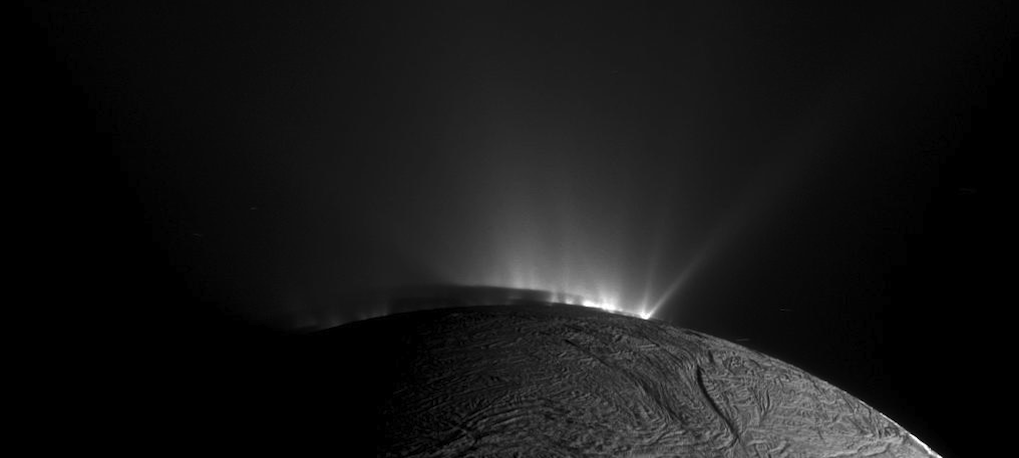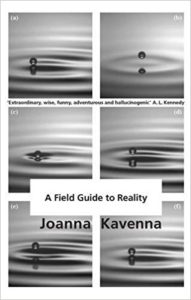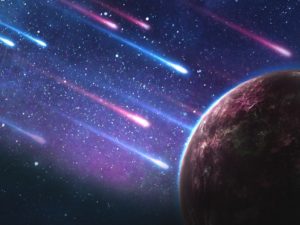
By Maureen Kincaid Speller
A Field Guide to Reality — Joanna Kavenna (riverrun)
 Back at the beginning of this project, when I chose Joanna Kavenna’s A Field Guide to Reality, I said this about my selection:
Back at the beginning of this project, when I chose Joanna Kavenna’s A Field Guide to Reality, I said this about my selection:
Joanna Kavenna’s novel attracts me partly because it’s set in a version of Oxford, my home city, and I’m a sucker for anything about my home city; partly because it seems to be illustrated and I’m also curious about attempts to bring together text and art, especially as they are often so horribly unsuccessful and I want to see if this wins rather than loses; and mainly, because I like the sound of a novel that partakes of quantum theory and metaphysics, and I want to find out if a novel that might be about science might be science fiction too. And it has to be said that if one is going to read a novel about alternative or imbricated realities, it is interesting to begin from a place one knows well.
So, because I am not sure I know how else to shape a review of this novel, I shall take those reasons as sub-headings.
The dream of everyday life
Oxford is the city of my birth, and though it is no longer my home, it is still home, the place where everything started, the place I will spend the rest of my life moving away from. There is no going back in reality but Oxford persists as ‘the consolatory elsewhere’, the place I can return to in my imagination, and especially through fiction.
Though, having said that, it is difficult to find fiction that offers up an Oxford I truly recognise; unsurprising, given my Oxford is not your Oxford, and never can be, any more than yours will be mine. Sometimes it’s a matter of evoking places and names in the right way at the right moment: old favourites include Penelope Lively’s The House in Norham Gardens and Philip Pullman’s Lyra’s Oxford (more so even than the His Dark Materials trilogy). Sometimes, it’s more a matter of creating a particular atmosphere, something A Field Guide to Reality turns out to be remarkably good at, all the more so given that Kavenna’s Oxford itself is an alternative city, where some of the names have stayed the same but some, especially those of things pertaining to the university, have changed. Is it important? Maybe.
What I know as the Ashmolean Museum is, in Kavenna’s Oxford, the Tradescantian Ark, reflecting the fact that the collection Elias Ashmole gave to Oxford University was in part composed of John Tradescant the Younger’s collection of artefacts, known as the Ark, which he gave to Ashmole (or, depending on who you listen to, which Ashmole swindled him out of). So, perhaps we are in an Oxford which is less a ‘home of lost causes, and forsaken beliefs, and unpopular names, and impossible loyalties’, as Matthew Arnold memorably described it, and instead a place where potential wrongs have been righted even before they were committed, and Jeremiah Tradescant’s ownership of his family’s remarkable collection is justly celebrated. Perhaps, but rather as light is both particle and wave, so wrongs can be righted even as the lost causes and forsaken beliefs persist.
Fluidity, of belief and materiality, is the essence of this Oxford. It’s signalled in the way this winter city is so often wreathed in mist, or rimed with frost, seeming constantly to be about to be erased as the fog swirls or the ice melts. It is a world without light, yet made of the purest light, according to Robert Grossteste, philosopher, who believes that white is ‘created by such fiery furious light in pure diaphaneity’. What is more diaphanous than misty veils? Except, perhaps, that concept of Oxford that I can never quite convey to you but which is as seductive to me as it is to Eliade Jencks, who came to Oxford because her mother believed she was destined to work at the Tradescantian Ark, and found she could stay only by becoming a waitress in the café in its basement. Light is replaced by opacity; Eliade believes herself to have ‘lost the diaphanous realm, or transparency. Now she is immersed in the turgid reality of the Oxford beyond the city walls, living somewhere up the Cowley Road, in an ‘atmosphere [that] was desolate’.
The art in the text, the text in the art
‘And what is the use of a book,’ thought Alice, ‘without pictures or conversation?’
I read Alice in Wonderland often as a child, even before I fully understood its connection to Oxford. The edition I read had pictures, of course, but I was more puzzled that Alice, so terribly grown-up as she seemed to be, didn’t understand the cachet of reading books without pictures, the sure-fire marker of adulthood.
Even now, I wonder a little about illustrated novels for adults; not graphic novels, but novels like this, with artwork dotting the pages, inserted between chapters. Some pictures are like doodles on a manuscript, left by a bored or inattentive monk. Their strength lies in their seeming artlessness: a gargoyle here, a sketch of a man in a deckchair there. They make me smile. They’re probably meant to. They’re heirs to a long tradition of entertaining marginalia. Other illustrations are more obviously intended to evoke a particular atmosphere: a rainbow on Port Meadow, the mist swirling around street lights somewhere on the Cowley Road; Solete’s house on Mesopotamia, that narrow strip of land in the Parks, between two strands of the River Cherwell; and a sketch of the café at the Tradescantian Museum, which suggests to me it is a very different building to the Ashmolean I recall. These illustrations seem to transform the novel into literally a guide, a guide to the Oxford that exists within the novel.
Strangely, though, it is when the art engages most closely with the text that it seems to be at its weakest, especially when figures are involved. It is as though Oly Ralfe works best as an evoker of feelings rather than as an illustrator of events and people. Certainly, I find his figures somewhat unconvincing at times. Eliade herself is a vague presence, sometimes lurking at the front of the picture: we always see her back, and seem to look over her shoulder, as though viewing her dreams and visions almost but not quite through her eyes.
But, I have come to realise, the presence of the art is important, because this novel is all about light and visibility, and how better to emphasise that than through illustration? Fiction is both word and picture.
Perception is a prevailing mystery of thought
Finally, we come to the novel itself. I was struck, looking at newspaper reviews, how reviewers have struggled with it. It defies a quick précis, as a result of which reviewers have focused on what seems to be the meat of the matter, the hunt for Solete’s life’s work, the Field Guide itself, while almost entirely ignoring the rest of the novel’s content. This is perhaps unsurprising, given it wrestles with a lot of complicated material about philosophies of light and visibility, but to ignore it is to present only a very limited view of the novel.
The novel opens with a scene on Port Meadow, ancient grazing land north and west of Oxford, and the appearance of a huge double rainbow in the year 1216. A sign from God, some people believe; others would argue that ‘rainbows derive from the reflection, by clouds, of the sun. The colours are caused by the dimming effect of clouds.’ We know now that rainbows are caused by the reflection, refraction and dispersion of light through water droplets, generally rain, but this opening sequence tells us an important thing: people are theorising about the nature and causes of the phenomena they see around them. Nowhere is this more intensely thought about than in Oxford, site of the first English university. As if to emphasise this, Kavenna then takes us on a whirlwind tour of early Oxford and the thoughts of its first chancellor, Robert Grosseteste. The mutability of his name’s spelling reminds us of myriad explanations of the natural world that already exist, even at this point. We travel with Grosseteste as he reviews the various theories of perception in what seems to be the most literal fashion imaginable. Such is his imagination he’s there, as philosophers propound their theories; if we’re wise, we take this as a pointer for what is to come later.
Fast forward to 2016, and to our narrator, Eliade Jencks, living in Oxford, living an in between life, neither student nor don (as though these are the only options available in Oxford even now), working in the Tradescantian Museum café, and carrying out unspecified research in the Great Library in the evenings. A phone call announces the death of Professor Solete, with whom Eliade was friends, and summons her to Nightingale Hall, where a box lies, waiting to be opened, her name written on it.
So far we seem to be caught up in an academic turf war, as Solete’s colleagues, who have been frantically searching for Solete’s magnum opus, which they now believe to be in Eliade’s box, come up with reasons why the box’s contents should belong to the college rather than to Eliade. It is deliciously naked and oh-so-Oxford in its way, and there is a great satisfaction in discovering, once the box is opened, that it is empty.
As most of Solete’s colleagues lose interest, it’s left to Eliade, and Anthony Yorke, a don, to figure out what Solete was actually working on and where he has hidden it. Which makes the novel sound like a detective story. In fact, it’s more accurately characterised as a journey through theories of perception and epistemology, how we come to understand our world, set against the history and geography of Oxford and varying perceptions of the city (though the one thing that is perhaps lacking is a fully-formed Town perspective. The Gown are inevitably contemptuous of the Town but Eliade herself is again neither one thing nor the other).
It can also, I think, be read as a kind of journey through the underworld of forsaken theory, each clue leading Eliade on to the next set of ideas. This would also account in part for the sense of the hallucinatory and the elusiveness of Eliade’s experiences, coupled with her as yet not fully articulated grief for her own father’s death as well as that of Solete as perhaps a substitute father. I’m prompted to say that in part because of Eliade’s unusual forename, which immediately makes me think of Mircea Eliade, the historian who posited the idea of the myth of the eternal return, and the shift between sacred and profane time and space. Early in their acquaintance, Yorke tells Eliade a story of how as a child he convinced his brother that if they tossed a dead mouse into the river the dead creature would return to them. Oxford, surrounded by rivers and by marshes, seems to be a place where the dead might come back to life, or at any rate, to lie uneasily, as witnessed in Robert Grosseteste’s visions and Eliade’s own dreams.
The novel’s denouement (and avert your eyes now if such things bother you, but I cannot discuss this novel without discussing its ending, not least because in this instance the ending is the novel) centres on Solete’s long journey through different theories of perception, to reach the understanding that ‘the fundamental mystery and central property of reality is light’. Solete could not express this in writing and instead built a construct to express his revelation: a theatre of dust, in the cellar of his house. ‘Seven rays of light seeped through the holes, and clouds of dust floated along these beams of light.’ It echoes the work of Alhazen, mentioned at the novel’s beginning, and famed for his work on demonstrating that light travels in straight lines. This of course is not what Solete’s colleagues want: they want papers they can edit and publish in a neat volume with their names on the front as editors. They will have their volume but for Eliade and Yorke their quest has also come to an end. As Yorke notes of Solete’s work, ‘in a perverse way, it is a theory of everything. Just not the one they want.’ Are Eliade and York happier for the knowing? It’s hard to say, but ultimately that is not what the novel is about. It is the journey rather than its ending that is important, the accruing of knowledge, the constant demand that they see the world anew.
The question has to be asked, as we seem to be asking of all the volumes on our shortlists, is this science fiction? It is undoubtedly fiction about science, but fiction about science isn’t necessarily good science fiction. I think there is a case for The Field Guide to Reality being science fiction, but in the same way that Arthur C. Clarke noted that ‘any sufficiently advanced technology is indistinguishable from magic’ I’m going to suggest that in this instance it’s remarkably difficult to disentangle the philosophical and the fantastical from the scientific. And that is the point. I could argue that A Field Guide to Reality is an alternative history, but that is a thin argument, and makes for thin fiction too. Equally weak and flimsy is to suggest that it might be a time-travel novel. My own feeling is that the time-travel is entirely in the imagination, ours and Eliade’s. I’m going to suggest instead that this novel is about the wonders of science and philosophy and the ways in which they have seemed magical and fantastical to those who have struggled to grasp the intricacies of theory. It may be that Eliade has dreamed the whole thing but I don’t think that undermines the nature of her quest for knowledge.
The first time I read this novel, I enjoyed it but there was so much to take in it was difficult to gain any mental purchase on it. The second time, having stowed away my preoccupations with its portrayal of Oxford, it was easier to start trying to get to grips with the theories underpinning the novel. Easier but not easy. There is an image employed in one section of this novel, of a giant chrysanthemum, unfolding its petals. It’s a disconcerting image when it arises but looking back it’s tempting to see it as a metaphor for the novel itself, in the way that it unfolds in complex patterns, different each time. And the more I read, the more I find to read.
*
1 Comment
-
One thing that these three slightly disparate reviews (yours, Nina’s, Jonathan’s) have convinced me of is that I really need to read this novel.


